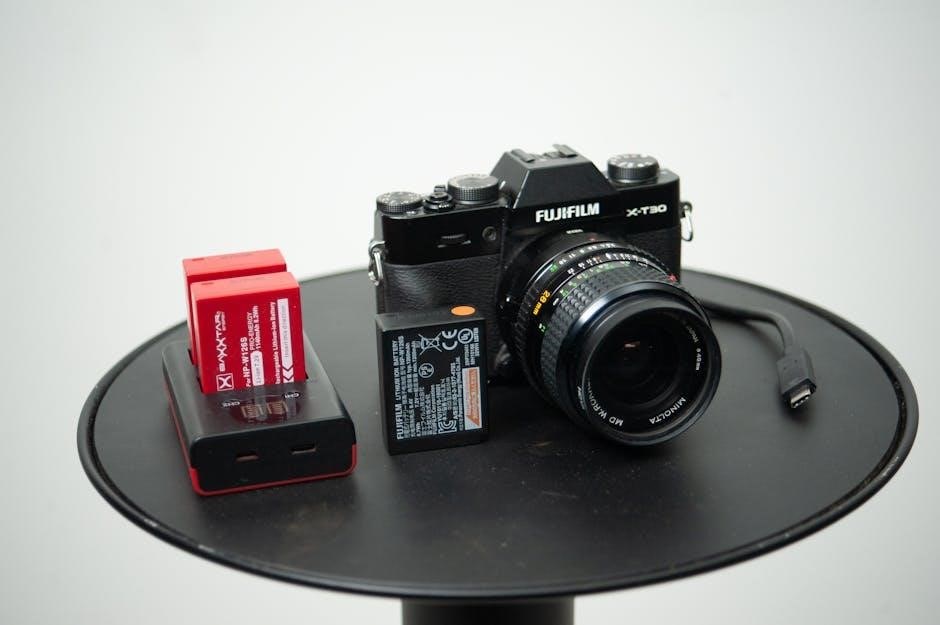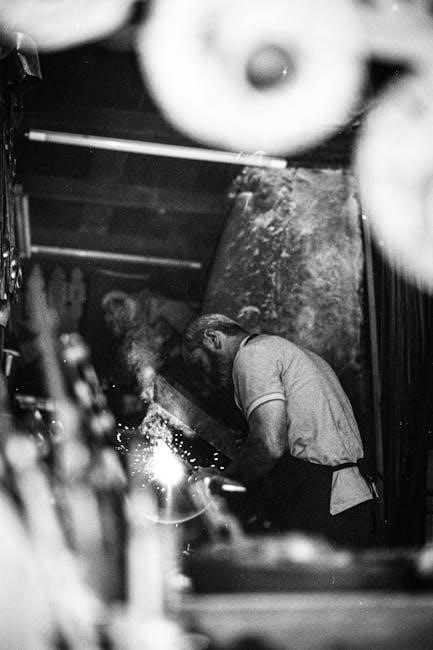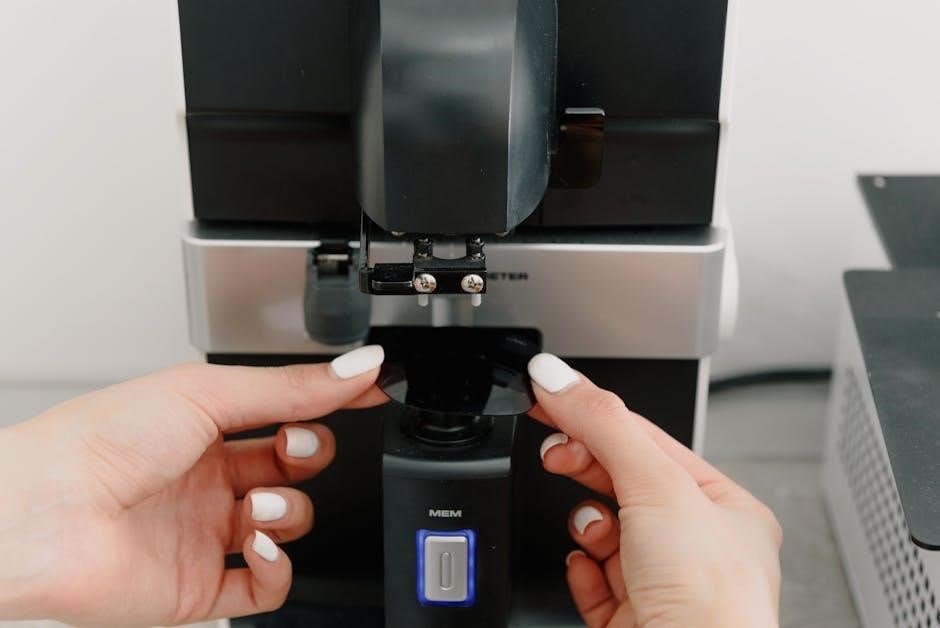The Nikon D3100 is a 14.2 MP DSLR camera designed for entry-level photographers. Its user manual provides detailed guidance on features like the 3-inch LCD‚ HD video recording‚ and Scene Auto Selector. Available online as a free PDF‚ it covers basic and advanced operations‚ troubleshooting‚ and maintenance tips to ensure optimal performance.
1.1 Overview of the Nikon D3100
The Nikon D3100 is a 14.2-megapixel entry-level digital single-lens reflex (DSLR) camera designed for photography enthusiasts and beginners. It features a CMOS sensor with a maximum image size of 4608 x 3072 pixels‚ offering high-quality images with vibrant colors. The camera is equipped with a 3-inch LCD screen‚ HD video recording capabilities‚ and an 11-point autofocus system for precise subject tracking. One of its standout features is the Scene Auto Selector‚ which automatically adjusts settings based on the shooting environment. Weighing approximately 455 grams‚ the D3100 is lightweight and portable‚ making it ideal for everyday use. The camera supports SD‚ SDHC‚ and SDXC memory cards‚ providing ample storage for photos and videos. With a user-friendly interface and guide mode‚ it helps new photographers understand and apply advanced techniques. The D3100 also supports HDMI and USB connectivity for easy image transfer and sharing. Its compatibility with Nikon F-mount lenses expands creative possibilities‚ allowing users to experiment with various focal lengths and effects. Overall‚ the Nikon D3100 is a versatile and accessible DSLR that balances performance and simplicity‚ making it a great choice for those looking to elevate their photography skills.
1.2 Target Audience and Intended Use
The Nikon D3100 is primarily designed for entry-level photographers and hobbyists seeking to enhance their photography skills. Its user-friendly interface and guide mode make it an ideal choice for beginners‚ while its advanced features appeal to intermediate users. The camera is also suitable for professionals looking for a lightweight backup or educators teaching photography fundamentals. It is intended for a variety of uses‚ including everyday photography‚ travel‚ portraits‚ and creative projects. The D3100’s portability and ease of use make it a great tool for capturing moments on the go. Additionally‚ its compatibility with a wide range of Nikon lenses and accessories allows users to explore different styles and techniques. The camera’s manual is tailored to help users of all skill levels‚ providing clear instructions for basic operations and advanced functionalities. Whether for personal use or educational purposes‚ the Nikon D3100 is a versatile tool designed to meet the needs of photography enthusiasts. Its guide mode and comprehensive manual ensure that users can gradually improve their skills and unlock the camera’s full potential.

Key Features
The Nikon D3100 features a 14.2 MP CMOS sensor‚ EXPEED 2 image processor‚ and ISO range of 100-12‚800. It supports 1080p HD video recording‚ a 3-inch LCD screen‚ and Scene Auto Selector for intuitive shooting in various conditions.
2.1 Sensor and Image Processor
The Nikon D3100 is equipped with a 14.2-megapixel APS-C CMOS sensor‚ delivering high-resolution images with excellent detail. The sensor works in conjunction with Nikon’s EXPEED 2 image processor‚ which enhances image quality by reducing noise and improving color accuracy; The EXPEED 2 also supports faster processing speeds‚ enabling smooth operation during continuous shooting and HD video recording. The camera’s sensor captures images with a maximum resolution of 4608 x 3072 pixels‚ ideal for enlargements and professional-grade photography. The combination of the CMOS sensor and EXPEED 2 processor ensures crisp‚ vibrant images even in challenging lighting conditions. This pairing is essential for the D3100’s performance‚ providing photographers with the tools to produce high-quality results consistently. Whether shooting in bright daylight or low-light environments‚ the sensor and processor work together to deliver outstanding performance for both stills and video. This makes the D3100 a reliable choice for photographers seeking a balance between quality and affordability.
2.2 ISO Range and Noise Performance
The Nikon D3100 features an ISO range of 100 to 6400‚ with the option to extend it to 12800 in Hi 1 mode‚ making it versatile for various lighting conditions. At lower ISO settings (100-800)‚ the camera delivers clean images with minimal noise‚ ensuring sharp details and vibrant colors. As the ISO increases‚ particularly beyond 1600‚ noise becomes more noticeable‚ especially in shadow areas. However‚ the D3100 handles noise relatively well for its class‚ producing usable images even at higher sensitivities.
When shooting in low-light environments‚ the camera’s noise reduction system helps mitigate grain‚ though it may slightly soften fine details. For the best results‚ it’s recommended to keep the ISO below 3200 unless absolutely necessary. Additionally‚ using a tripod or external flash in low-light conditions can help minimize the need for high ISO settings. Overall‚ the D3100’s ISO performance is robust for an entry-level DSLR‚ offering flexibility for photographers to capture high-quality images in diverse scenarios.

Camera Components
The Nikon D3100 features a 14.2MP DX-format CMOS sensor‚ a 3-inch LCD screen‚ and an optical viewfinder. It includes a built-in flash‚ hot shoe‚ and supports AF-S lenses via its F-mount. These components ensure versatility for photographers.

3.1 External Controls and Layout
The Nikon D3100 features a well-organized external control layout designed for intuitive operation. On the top‚ the mode dial allows quick access to shooting modes like Auto‚ P‚ S‚ A‚ and M. The shutter release button‚ surrounded by the zoom control‚ is positioned on the top right for easy reach. The aperture/exposure compensation button is located nearby for quick adjustments.
On the rear‚ the multi-selector (D-pad) provides navigation for menu options and autofocus point selection. The live view and video recording buttons are conveniently placed for easy access. The playback and menu buttons are positioned for thumb operation‚ while the delete button is located on the lower left.
The camera also includes a hot shoe for external flash units and a built-in pop-up flash. The memory card slot and ports (HDMI and USB) are located on the sides for connectivity. The ergonomic design ensures a comfortable grip‚ with controls logically placed to minimize hand movement during shooting. This layout caters to both beginners and experienced photographers‚ offering easy access to essential functions while maintaining a streamlined interface.
3.2 Lens Compatibility and Mount Type
The Nikon D3100 utilizes the Nikon F-mount‚ ensuring compatibility with a wide range of lenses‚ including AF-S‚ AF‚ and older manual-focus lenses. This versatility allows photographers to choose from Nikon’s extensive lens lineup or use legacy lenses with proper adapters. However‚ older lenses may require manual focusing and could have limited metering compatibility.
The camera is designed to work seamlessly with DX-format lenses‚ which are optimized for its APS-C sensor. These lenses provide a 1.5x crop factor‚ effectively extending the focal length of FX lenses when used on the D3100. While FX lenses are compatible‚ they may not utilize their full-frame capabilities on this camera.
Third-party lenses from manufacturers like Sigma‚ Tamron‚ and Tokina are also compatible‚ offering cost-effective alternatives for photographers. However‚ compatibility and performance may vary depending on the lens model and manufacturer.

Overall‚ the Nikon D3100’s F-mount and DX-format sensor provide a flexible foundation for photographers to explore various lens options‚ balancing affordability‚ creativity‚ and performance.

Shooting Modes
The Nikon D3100 offers a variety of shooting modes to enhance creativity and control‚ catering to both beginners and advanced photographers. These modes provide flexibility for different photography scenarios‚ ensuring optimal results in diverse lighting and compositional conditions.
4.1 Auto and Scene Modes
The Nikon D3100 features a range of Auto and Scene modes designed to simplify photography for users of all skill levels. The Auto Mode automatically adjusts settings for optimal results in various conditions‚ making it ideal for beginners or casual shooting. Additionally‚ the camera offers 12 Scene Modes‚ including Portrait‚ Landscape‚ Child‚ Sports‚ Close-up‚ Night Portrait‚ Night Landscape‚ Party/Indoor‚ Beach/Snow‚ Sunset‚ Dusk/Dawn‚ and Pet Portrait. Each mode is tailored to specific scenarios‚ adjusting parameters like aperture‚ shutter speed‚ and ISO to capture the best possible image.
- Portrait Mode prioritizes subject focus and softens backgrounds.
- Landscape Mode ensures sharpness and vibrant colors for scenic shots.
- Night Portrait Mode balances subject and background lighting in low-light conditions.
- Sports Mode freezes fast-moving subjects with faster shutter speeds.
These modes allow users to focus on composition and creativity while the camera handles technical details‚ making photography more accessible and enjoyable.
4.2 Manual and Priority Modes
The Nikon D3100 offers advanced shooting modes for users seeking greater control over their photography. These modes include Programmed Auto (P)‚ Shutter-Priority (S)‚ Aperture-Priority (A)‚ and Manual (M). Programmed Auto mode allows for automatic settings but enables adjustments to ISO‚ autofocus‚ and exposure compensation. Shutter-Priority mode lets users set the shutter speed‚ ideal for capturing motion or freezing fast-moving subjects‚ while the camera adjusts the aperture automatically.
- Aperture-Priority mode enables manual control over aperture‚ useful for managing depth of field in portraits or landscapes.
- Manual mode provides full control over both aperture and shutter speed‚ allowing for precise adjustments to achieve desired effects.
- Exposure compensation and metering modes can be adjusted in these settings to fine-tune results.
These modes cater to intermediate and advanced photographers‚ offering flexibility and creative control while maintaining the camera’s ability to assist where needed. They are ideal for experimenting with different techniques and achieving specific artistic outcomes‚ making them essential tools for mastering photography with the D3100.

Playback and Editing
The Nikon D3100 allows users to review images‚ delete unwanted photos‚ and create slideshows. Basic editing features include resizing‚ cropping‚ and applying filter effects. These tools enable quick adjustments without a computer‚ enhancing workflow efficiency.
5.1 Reviewing and Managing Images
The Nikon D3100 provides a user-friendly interface for reviewing and managing images. Pressing the playback button displays captured photos on the 3-inch LCD screen. Users can scroll through images using the left and right arrow keys. The camera offers basic image management options‚ such as deleting unwanted photos or protecting favorites to prevent accidental deletion.
The D3100 also features a retouch menu‚ allowing in-camera editing options like resizing‚ cropping‚ and applying filter effects. Additionally‚ images can be rotated to correct orientation. This makes it easy to organize and refine photos without transferring them to a computer.
Furthermore‚ the camera supports slide shows‚ enabling users to view their photos in a sequence. The LCD screen’s adjustable brightness ensures clear visibility in various lighting conditions. These features make managing and reviewing images on the D3100 both efficient and convenient for photographers of all skill levels.
5.2 Basic In-Camera Editing Options
The Nikon D3100 offers a variety of basic in-camera editing options through its Retouch Menu‚ allowing users to enhance and modify images without transferring them to a computer. One of the key features is the Trim option‚ which enables cropping of images to focus on specific areas of the photo. This is particularly useful for refining compositions or removing unwanted elements from the frame.
Additionally‚ the D3100 provides Filter Effects‚ including options like Sepia‚ Black-and-White‚ and Cyanotype. These filters allow users to apply creative styles to their photos‚ giving them a unique aesthetic. Another notable feature is the Image Overlay option‚ which lets users combine two images into a single photo‚ creating interesting and artistic effects.
The camera also includes a Red-eye Correction tool‚ which automatically detects and corrects red-eye in portraits taken with flash. These editing options are intuitive and easy to use‚ making the Nikon D3100 a versatile tool for both shooting and basic post-processing.

Custom Settings
The Nikon D3100 allows users to customize camera functions to suit their preferences. Custom settings include button assignments‚ exposure adjustments‚ autofocus modes‚ and metering options. These settings enhance shooting efficiency and personalization for photographers.
6.1 Autofocus and Metering Modes
The Nikon D3100 offers flexible autofocus and metering options to adapt to various shooting conditions. Autofocus modes include Single AF for stationary subjects and Continuous AF for moving subjects. Additionally‚ Auto AF mode automatically switches between the two. The camera also features Manual Focus for precise control.
For metering‚ the D3100 provides three modes: 3D Color Matrix Metering II for balanced exposures‚ Center-Weighted Metering to prioritize the central area‚ and Spot Metering for precise light measurement from a small section. These modes ensure accurate exposure in diverse lighting scenarios.
Users can customize autofocus and metering settings via the camera’s menu system‚ allowing for tailored configurations. For example‚ the AF-Area Mode can be set to Single-Point AF‚ Dynamic-Area AF‚ or Auto-Area AF‚ depending on the scene. Metering modes can also be combined with other settings‚ such as ISO and white balance‚ for optimal results.
Customizing these settings enables photographers to achieve consistent and professional-looking images‚ making the D3100 versatile for both beginners and experienced users.
6.2 White Balance and Bracketing
The Nikon D3100 offers robust white balance and bracketing features to enhance image quality. White balance ensures accurate color representation by adjusting for lighting conditions. The camera provides multiple modes‚ including Auto‚ Daylight‚ Tungsten‚ Fluorescent‚ Cloudy‚ Shade‚ and Custom. The Custom White Balance allows users to set a specific color temperature for precise control.
Bracketing is another powerful tool‚ enabling the capture of multiple exposures of the same scene at different settings. The D3100 supports Exposure Bracketing‚ which takes up to three shots at varying exposure levels. This is ideal for capturing high-contrast scenes‚ as it allows for later merging into a single image with expanded dynamic range. Bracketing intervals can be adjusted‚ providing flexibility for different lighting conditions.
Both white balance and bracketing settings are easily accessible via the camera’s menu system‚ making it simple to tailor these features to specific shooting scenarios. These tools empower photographers to achieve more accurate and creative results‚ whether in everyday shooting or challenging lighting environments.

Connectivity and Accessories
The Nikon D3100 offers versatile connectivity options‚ including HDMI and USB ports for easy image transfer and camera control. Compatible accessories like remote shutters and external microphones enhance functionality‚ ensuring seamless integration with various devices and workflows.
7.1 HDMI and USB Connections
The Nikon D3100 features HDMI and USB connections‚ enabling seamless image and video transfer to external devices. The HDMI output allows users to review photos and videos on HD televisions or monitors‚ providing a high-quality preview of captured content. The USB port supports data transfer to computers‚ making it easy to upload images for editing or sharing. Both connections are compatible with standard cables‚ ensuring reliability and convenience. The HDMI connection is particularly useful for photographers who want to showcase their work on larger screens‚ while the USB port offers a straightforward way to back up files. Additionally‚ the USB connection can be used to control the camera remotely using Nikon software‚ enhancing workflow efficiency. These connectivity options make the D3100 a versatile tool for both amateur and professional photographers‚ ensuring easy integration with modern devices and workflows.
- HDMI output for HD image and video playback.
- USB port for data transfer and camera control.
- Compatibility with standard HDMI and USB cables.
- Enhanced connectivity for sharing and editing content.
7.2 Compatible Accessories and Peripherals
The Nikon D3100 is compatible with a wide range of accessories and peripherals‚ enhancing its functionality and versatility. These include high-capacity memory cards‚ such as SD‚ SDHC‚ and SDXC cards‚ which ensure ample storage for photos and videos. The camera supports Nikon’s EN-EL14 rechargeable lithium-ion battery‚ providing long shooting sessions. Additional accessories like the MH-24 battery charger and optional AC adapters are available for convenient power management. For expanded creativity‚ the D3100 is compatible with Nikon’s F-mount lenses‚ including AF-S‚ AF‚ and DX lenses‚ offering a wide range of focal lengths and aperture options. External flashes‚ such as the SB-400 and SB-700‚ can be attached via the hot shoe for improved lighting control. Other peripherals include remote shutter releases‚ tripod adapters‚ and camera bags‚ all designed to enhance the shooting experience. Each accessory is crafted to integrate seamlessly with the D3100‚ ensuring optimal performance and ease of use.
- Memory cards: SD‚ SDHC‚ and SDXC formats.
- Battery and charging solutions: EN-EL14 and MH-24 charger.
- Lens compatibility: F-mount‚ AF-S‚ AF‚ and DX lenses.
- External flashes: SB-400‚ SB-700‚ and Nikon Creative Lighting System compatibility.
- Remote controls and tripod adapters for stable shooting.
- High-quality camera bags for protection and portability.

Maintenance and Troubleshooting
Regularly clean the sensor and lens to prevent dust and smudges. Update firmware for optimal performance. Store the camera in a dry‚ cool place to avoid damage. Troubleshoot common issues like error messages or battery drain by consulting the manual or Nikon support.
8.1 Cleaning and Updating the Camera
Proper maintenance ensures the Nikon D3100 performs optimally. Clean the image sensor using a soft-bristle brush or blower to remove dust. For stubborn spots‚ use a swab with Eclipse cleaning solution. Avoid touching the sensor surface to prevent damage.
- Clean the lens with a microfiber cloth and gentle cleaning solution to remove smudges and fingerprints.
- Update the camera firmware regularly via Nikon’s official website for improved features and bug fixes. Download the update to a memory card and follow on-screen instructions.
- Inspect external controls and clean them with a damp cloth if necessary. Ensure all buttons and dials function smoothly.
- Store the camera in a cool‚ dry place to prevent moisture damage. Use a silica gel packet in the storage case to absorb humidity.
- Refer to Nikon’s guidelines for detailed cleaning and maintenance procedures to avoid voiding the warranty.
Regular maintenance extends the camera’s lifespan and ensures sharp‚ clear images. Always handle the camera with care to prevent accidental damage.
8.2 Common Issues and Solutions
Like any camera‚ the Nikon D3100 may encounter issues that can be resolved with simple troubleshooting. One common problem is memory card errors‚ which can often be fixed by formatting the card in the camera or using a card reader. If the camera fails to recognize the memory card‚ ensure it is compatible and properly inserted.
- If the battery drains quickly‚ check for firmware updates or reset the camera to factory settings. Avoid using third-party batteries‚ as they may not be optimized for the D3100.
- Autofocus issues can occur in low light. Use the AF-assist light or switch to manual focus for better results. Clean the lens and sensor regularly to avoid focusing problems.
- Image noise in low-light conditions is common. Use the lowest necessary ISO and apply noise reduction in post-processing software like Nikon ViewNX or Adobe Lightroom.
- If the LCD screen appears dim or faded‚ adjust the brightness settings or reset the camera. Ensure the screen protector is clean and free of scratches.
- For connectivity issues‚ ensure the USB cable is securely connected and compatible with your computer. Update the camera drivers if necessary.
These solutions address many common issues‚ helping you maintain optimal performance and extend the life of your Nikon D3100.
